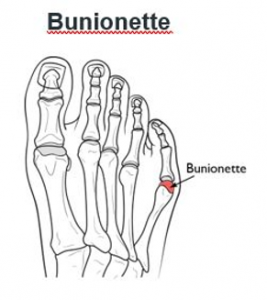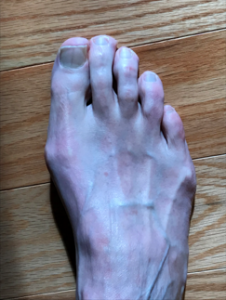
A bunionette, or "tailor's bunion," occurs on the outside of the foot near the base of the little toe. It is on the opposite side of the big toe and is smaller than a bunion. The fifth metatarsal deviates laterally and the fifth toe medially. Although it is in a different spot on the foot, a bunionette can also be painful. Like its bunion counterpart, a bunionette has a high association with constrictive shoes and is much more common in women than in men. Proper fitting shoes are an essential part of reducing discomfort.
Foot Type and Bunionettes
Some people have an inherited foot structure with long bones that tend to bow and form bunionettes. The most frequent cause of bunionettes is poor fitting shoes that compress the foot structures. Women are more likely to develop bunionettes than men because they are more likely to wear shoes with a tight narrow toe box. Bunions are more common in individuals with neutral or flat feet. People with bunionettes often have bunions as well.

The Role of Orthotics in Managing Bunionettes
Foot orthotics act as an intermediary between the foot and the ground to reduce the stress placed on the forefoot, bunion, and bunionette when weight-bearing. Orthotics can help protect and improve the alignment of the midfoot and forefoot reducing the angular forces placed on the bunion and bunionette which helps relieve pain. Properly designed foot type-specific orthotics and well-fitting shoes can help reduce pain and keep the bunion and bunionette from getting worse.
Sole Remedy is accredited by the American Board for Certification for Orthotics, Prosthetics and Pedorthics (ABCOP), and provider of ankle-foot orthoses, foot orthotics, and proper fitting footwear.
We can help with painful bunions, gait abnormalities, and properly fitting shoes.
Call today for an appointment!
Sole Remedy specializes in gait analysis, foot type assessment, musculoskeletal injury management, and fall prevention.
Phone: 508-295-8800 or 855-FOOT RX 9 to schedule an appointment today!
